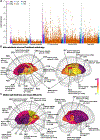Heart-brain connections: Phenotypic and genetic insights from magnetic resonance images
- PMID: 37262162
- PMCID: PMC11987082
- DOI: 10.1126/science.abn6598
Heart-brain connections: Phenotypic and genetic insights from magnetic resonance images
Abstract
Cardiovascular health interacts with cognitive and mental health in complex ways, yet little is known about the phenotypic and genetic links of heart-brain systems. We quantified heart-brain connections using multiorgan magnetic resonance imaging (MRI) data from more than 40,000 subjects. Heart MRI traits displayed numerous association patterns with brain gray matter morphometry, white matter microstructure, and functional networks. We identified 80 associated genomic loci (P < 6.09 × 10-10) for heart MRI traits, which shared genetic influences with cardiovascular and brain diseases. Genetic correlations were observed between heart MRI traits and brain-related traits and disorders. Mendelian randomization suggests that heart conditions may causally contribute to brain disorders. Our results advance a multiorgan perspective on human health by revealing heart-brain connections and shared genetic influences.
Conflict of interest statement
Figures






Comment in
-
Unravelling the genetic heart-brain connection using MRI.Nat Rev Cardiol. 2023 Aug;20(8):513. doi: 10.1038/s41569-023-00905-y. Nat Rev Cardiol. 2023. PMID: 37337022 No abstract available.
-
Cardiovascular MRI traits are genetically linked to brain pathophysiology.Nat Cardiovasc Res. 2023 Jul;2(7):602. doi: 10.1038/s44161-023-00304-z. Nat Cardiovasc Res. 2023. PMID: 39195925 No abstract available.
References
MeSH terms
Grants and funding
LinkOut - more resources
Full Text Sources
Medical

